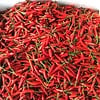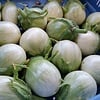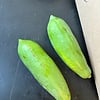Fresh pepper thai
Whole fresh peppercorns still on the stem are thrown into some dishes, notably ‘Phad Kee Mao’ and ‘Gaeng Paa’.
Storage: Store fresh peppercorns sealed in the refrigerator. They should last a few weeks or so.
Description/Taste
Green peppercorns grow on a woody stemmed vine that can climb up to 10 meters in the wild. It is a perennial evergreen that produces dark green ovate leaves 15 cm long with trailing yellowish-green florets that bloom in the summer. The flowers will eventually ripen into the spherical peppercorn fruits that first appear green and eventually turn red at the time of harvest. Foraged Green peppercorns have a more mild spice but offer a complex fresh vegetal flavor with a chewy texture that pops. When foraging, select berries with a slight sheen and tightly clustered together. Fresh Green peppercorns are quite perishable and commonly found preserved in brine or pickled.
Seasons/Availability
In tropical regions Green peppercorns are available year-round. Fresh Green peppercorns can be found daily in the wet markets of Thailand and other Southeast Asian countries.
Current Facts
Peppercorns, whether black, white or green, all come from the same flowering vine botanically known as Piper nigrum. Green peppercorns are the fresh fruit that will later go through a drying process to yield the more common black peppercorns. White peppercorns are the inner seed of the black peppercorns with the outer skin removed. The term “pink peppercorn” is a misnomer as it is not actually a peppercorn but the ripe berry from the ornamental Brazilian pepper tree. It is often used as a peppercorn in culinary applications due to its similar appearance and mildly spiced flavor. Green peppercorns may be used fresh, brined, pickled or freeze-dried.
Nutritional Value
Green peppercorns are high in iron, vitamin K, and antioxidants. Piperine is a chemical found in Green peppercorns that may have anti-cancer properties. The oil derived from Green peppercorns is used to treat rheumatism, chills, flu, colds, poor circulation, exhaustion and muscular aches.
Applications
The bright piquant flavor of Green peppercorns adds a refreshing contrast to rich meats and creamy cheeses. Add the brined Green peppercorns into sauces for beef or use the crushed Green peppercorns to encrust soft goat cheese. Green peppercorns are popular in French, Thai, and Western European cuisines. They complement seafood, poultry, grilled meats, pates, butter, cream, white sauce, white wine, mustard, curry and parsley.
Ethnic/Cultural Info
Peppercorns have been valued more than gold throughout history. It was even used as currency in ancient Greece and Rome. During the middle ages, peppercorns were accepted in lieu of money for dowries, rent and taxes. In 408 A.D. the Visigoths attacked Rome and demanded 3,000 pounds of pepper as part of the city's ransom. Rameses II, a King of ancient Egypt, was found with peppercorns in his nasal cavity as part of his mummification.
Geography/History
The pepper vine is native to southern India and Sri Lanka, and has been used in Indian cooking since at least 2000 B. C. Today, it grows in tropical regions where temperatures range from 55-90 F including Malabar, Malacca, Sumatra, Java, Borneo, the Philippines, Japan and the West Indies.



 vegetables
vegetables
 fruit
fruit
 chilli
chilli
 eggplant thai
eggplant thai
 NEW project - GREEN PAPAYA THAI.
NEW project - GREEN PAPAYA THAI.
 Zuurzak - Guanabana
Zuurzak - Guanabana
